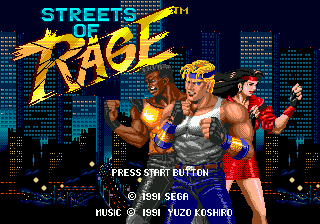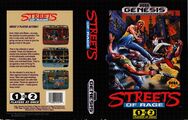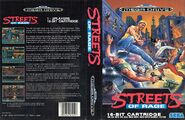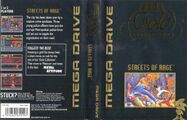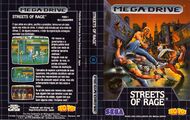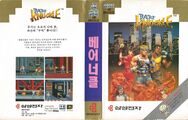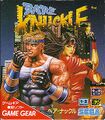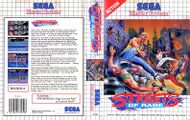Difference between revisions of "Streets of Rage"
From Sega Retro
m (Text replace - " \[\[Category:(Mega Drive Games|1988 Mega Drive Games|1989 Mega Drive Games|1990 Mega Drive Games|1991 Mega Drive Games|1992 Mega Drive Games|1993 Mega Drive Games|1994 Mega Drive Games|1995 Mega Drive Games|1996 Mega Drive Games|1997 Mega) |
(→Master System Version: micromania rating) |
||
| Line 221: | Line 221: | ||
| megaforce=74 | | megaforce=74 | ||
| megafun=78 | | megafun=78 | ||
| + | | micromania=80 | ||
| + | | micromania_source={{num|2/60}} | ||
| playerone=80 | | playerone=80 | ||
}} | }} | ||
Revision as of 16:34, 24 May 2012
| Streets of Rage | |||||
|---|---|---|---|---|---|
| System(s): Sega Mega Drive, Sega Game Gear, Sega Master System, Virtual Console, iOS, Steam | |||||
| Publisher: Sega | |||||
| Developer: Sega AM7, Ancient | |||||
| Peripherals supported: Gear-to-Gear Cable | |||||
| Genre: Action | |||||
| |||||
|
CERO
Missing Parameter! |
Streets of Rage, called Bare Knuckle: Ikari no Tetsuken (ベア・ナックル 怒りの鉄拳) in Japan, is a beat 'em up video game developed by Sega for the Sega Mega Drive. Its success meant that versions for the Sega Game Gear and Sega Master System were produced, with the latter being a European exclusive. It was the first in the Streets of Rage series and is a popular choice for compilations and Mega Drive re-releases for modern video game platforms.
Streets of Rage was primarily Sega's answer to Capcom's Final Fight, a very successful arcade game which Capcom had chosen to port to the Super Nintendo Entertainment System. Perhaps worried that this would divert attention away from the Mega Drive, Streets of Rage was created as a Sega exclusive, developed internally by Sega AM7. At the time of release, beat-'em-up games were very popular and Sega's title was no exception.
The music for Streets of Rage was composed by Yuzo Koshiro, who had previously offered his talents for Revenge of Shinobi. Koshiro's soundtrack would be widely praised, and he would be carried through into the development process of two sequels, Streets of Rage 2 and Streets of Rage 3, respectively.
Contents
Storyline
The game's Storyline takes place in a city that resembles New York. The city had been taken over by an evil syndicate, headed by the evil Mr. X. Chaos ensues and out of it comes three brave ex-cops: Axel Stone, Blaze Fielding, and Adam Hunter. Together they are willing to risk everything including their own lives to free the city from the evil syndicate.
The opening sequence text says:
| “ | This city was once a happy, peaceful place...until one day, a powerful secret criminal organization took over. This vicious syndicate soon had control of the government and even the police force. The city has become a center of violence where no one is safe.
Amid this turmoil, group of young Police officers has sworn to clean up the city. Among them are Adam Hunter, Axel Stone, and Blaze Fielding. They are willing to risk anything...even their lives...on the... Streets of Rage |
„ |
Characters
Playable Characters
Axel Stone: Axel is the leader of the three. He is a 22 year-old white blond male who is skilled at Martial Arts and loves to play video games. Axel is one of only two characters who appear in all three Streets of Rage Games. (The other one being Blaze Fielding.)
Adam Hunter: Adam is the powerhouse of the three. Adam is a black 23 year old male who excels in boxing. His weakness is that he moves more slowly than Axel and Blaze which makes handling Adam somewhat difficult.
Blaze Fielding: Blaze is a 21 year old white female. She enjoys lambada as a hobby and masters at judo martial arts. Blaze is physically weaker than Axel and Adam. However, what she lacks in physical strength she makes up for with speed. Blaze is an excellent choice for new players who are trying to master the game.
Bosses
The following names come from the Japanese manual:
Antonio: Antonio is the boss of Round 1. As his name implies, he wields a large boomerang and can sometimes kick. Antonio also appears in Round 8.
Souther: Souther is the boss of Round 2. He has claws attached to his gloves and can lunge at the player from far away. He can also counter the players' flying kicks with a slashing attack that leaves after images (it is possible to hit him with a flying kick but difficult to do and not recommended). In Round 6, two Souther will appear as the boss. He also appears in Round 8. Souther's name is reused as an alternate name for a similar enemy encountered in Streets of Rage 2 named Zamza. It is unknown if these characters are the same person but it is highly unlikely.
Abadede: Abadede is the boss of Round 3. He is a muscular brute who can charge and punch from long distances. He also appears in Round 5, and Round 8. He returns in Streets of Rage 2 with some new tricks up his sleeves.
Bongo: Bongo is the boss of Round 4. He is a big-bellied fighter who can breath fire and walk quickly across the screen diagonally. A player will take damage if he or she attempts to throw him. He also appears in Round 6, and Round 8. An enemy similar to Bongo, but unknown if it is the same person or not, Big Ben, appears in Streets of Rage 2 and 3. In Bare Knuckle III, he's more commonly called Bongo just like this Boss. Though similar, it is unknown if they are somehow the same person or not.
Onihime and Yasha: Onihime and Yasha are twins who resemble Blaze. Because they attack together and are always jumping around, they can be difficult to defeat. Their most common attacks are kicking in midair and grappling. They also appear again in Round 8. The also return in Bare Knuckle III but in Streets of Rage 3 they were renamed Mona and Lisa.
Mr. X: Mr.X is the final boss and head of the syndicate. He is the main antagonist throughout the series. Generally he carries around a machine gun when fighting or sits on his throne sicking goons on the player. However in Streets of Rage 3, he has been reduced to a brain inside a jar.
Regular Enemies
Garcia/Galsia: This is the first and most common punk encountered throughout the game. Galsia (as he's better known in SOR 2 as.) attacks the player frequently and sometimes has either knives or baseball bats to attack the player with. He has two different knife attacks. There's one where he walks across screen holding the knife in front of himself and knocking the player down if he runs into them. Then there's the other one where he'll hold knives and throw them at you. This version will not drop knives even if you throw him and is more commonly encountered on higher difficulties. Galsia has returned in all of the Streets of Rage/ Bare Knuckle games. In the other two, he's often paired with another enemy called Donovan.
Nora: Nora is a female enemy who carries a whip. According to the Japanese manual, she works for questionable members-only clubs where everyone calls her queen. Nora uses her whip to hit and knock down the player. Some Nora enemies may get down on their hands and knees if hit and you'll be unable to hit them until they get up. The ones that do this depend upon difficulty. Throwing them prevents them from doing this. Predecessor to the Electra enemy from the other games.
Y.Signal: A somewhat common enemy who has a mohawk. Y.Signal will punch the player sometimes, however he loves to throw the player and do sliding kicks to knock them off of their feet. Uses the sliding kicks and throws more often on higher difficulties. Appears again in the other two games as well.
Haku-Oh: Although sharing a similarly pronounced name to the martial artist who appears in Streets of Rage 2, Haku-Oh is quite different. According to the Japanese manual, he is a student of the 4000 year old Chinese art of Shaolin Kung Fu. Also mentioned that his ruthlessness is why he became a member of the syndicate. Haku-Oh uses flying kicks on the player and has a habit of jumping from behind scenery in some stages, such as the boat in Round 5.
Jack: Not to be confused with the knife-wielding punk from Streets of Rage 2 or one of the names for the Vice enemy in the US version of Streets of Rage 3. Jack is a Juggler who will juggle dangerous things such as hatchets or torches and throws them at the player occasionally. Occasionally, you may come across certain ones who seem to not have weapons. They actually do have weapons, but they only throw them and only if the player stands still long enough. What is thrown is either a hattchet or a torch. Despite this, the weaponless ones are easy to handle unless other enemies are nearby to protect them. Walking into a Jack who is armed will knock the player down if they aren't careful. According to the Japanese manual, Jack works part time as a circus clown and despite being funny for a living, is quite strong. In beta images, his outfit is very different and he seems dressed similar to Galsia.
Gameplay
Gameplay is typical for a beat-'em-up. Use ![]() to punch and
to punch and ![]() to jump. In midair,
to jump. In midair, ![]() throws a jumping kick. If the player is standing over a weapon the enemy dropped, use
throws a jumping kick. If the player is standing over a weapon the enemy dropped, use ![]() to pick it up and
to pick it up and ![]() to use it. Pressing
to use it. Pressing ![]() and
and ![]() together will trigger a rear attack. The player can grapple an enemy by coming close without being attacked.
together will trigger a rear attack. The player can grapple an enemy by coming close without being attacked.
In Streets of Rage, the player can call for a police car with ![]() . Upon doing so, the sunroof on the police car opens and a police officer fires a bazooka with a flare bomb in a Golden Axe-esque way. In multiplayer games when player two calls for the car the police officer uses and even bigger gun and tons of blasts rain down in a meteor shower fashion causing large explosions.
. Upon doing so, the sunroof on the police car opens and a police officer fires a bazooka with a flare bomb in a Golden Axe-esque way. In multiplayer games when player two calls for the car the police officer uses and even bigger gun and tons of blasts rain down in a meteor shower fashion causing large explosions.
Soundtrack
The soundtrack was composed by Yuzo Koshiro. A slightly enhanced soundtrack is available (but was only sold in Japan) containing three beta tracks not available anywhere else. The first beta track is Up and Up. It has been said that it would have been used in round 7 but was replaced by Violent Breathing. The other track is called Super Threc (which is considered by some to be a typo so it should actually read "Super Three") The last track is Name Entry and has been theorized by some to be what played during the high score screen because the jingle that supposedly replaced it (which is a duplicate of the Round Clear theme.) also says Name Entry in the Sound Test. This Soundtrack was made using a Soundboard II sound chip rather than the Mega Drive's sound chip. Yuzo Koshiro also included Arrange remixes of The Last Soul, Keep the Groovin, You Became the Bad Guy, Fighting in the Streets, and The Street of Rage as bonus tracks in the album.
This soundtrack was rereleased with somewhat better quality in 2007 as part of the Yuzo Koshiro Best Album series. The original version of the soundtrack while easier to find an official copy of than the Bare Knuckle III Soundtrack, is still quite rare. The arrange tracks are not in the 2007 iteration of the soundtrack for some reason.
Manuals
Production Credits
Mega Drive Version
Game Designed by: There Is "No" Accounting for Tastes., Tinon
Programmed by: Momonga Momo, Little Sun
Designed by: Seishi Atsumiya, Nandemo, Rascal Fuku-Chan, Udi
Music by: Yuzo Koshiro
Sound Assisted: T.N
Special Thanks to: Bo, Ore, Kottu, Thunder, Yamaichi, Scott
Presented by: Sega 1991
Game Gear Version
Game Designed by: Abadede
Programmed by: Nag, AT1000, IK
Designed by: Abadede, Honey
Music by: Yuzo Koshiro, Mikito Ichikawa
Special Thanks to: Mul, Kei
Presented by: Sega 1992
Physical Scans
Mega Drive Version
| 84 | |
|---|---|
| Based on 46 reviews | |
| Mega Drive, US (Sega Classic) |
|---|
| Mega Drive, AU (Sega Gold Collection) |
|---|
Game Gear Version
| Sega Retro Average | |||||||||||||||||||||||||||||||||||||||||||||||||||||||||||||||||||||||||||||||||||||||||||||||||||||||||||||||||||||||||||||||||
|---|---|---|---|---|---|---|---|---|---|---|---|---|---|---|---|---|---|---|---|---|---|---|---|---|---|---|---|---|---|---|---|---|---|---|---|---|---|---|---|---|---|---|---|---|---|---|---|---|---|---|---|---|---|---|---|---|---|---|---|---|---|---|---|---|---|---|---|---|---|---|---|---|---|---|---|---|---|---|---|---|---|---|---|---|---|---|---|---|---|---|---|---|---|---|---|---|---|---|---|---|---|---|---|---|---|---|---|---|---|---|---|---|---|---|---|---|---|---|---|---|---|---|---|---|---|---|---|---|---|
|
| 77 | |
|---|---|
| Based on 25 reviews | |
| Game Gear, US |
|---|
<div style="margin:auto; max-width:Expression error: Unexpected < operator.px">
 Cover
|
Master System Version
| Sega Retro Average | ||||||||||||||||||||||||||||||||||||||||||||||||||||||||||||||||||||||||||
|---|---|---|---|---|---|---|---|---|---|---|---|---|---|---|---|---|---|---|---|---|---|---|---|---|---|---|---|---|---|---|---|---|---|---|---|---|---|---|---|---|---|---|---|---|---|---|---|---|---|---|---|---|---|---|---|---|---|---|---|---|---|---|---|---|---|---|---|---|---|---|---|---|---|---|
|
| 76 | |
|---|---|
| Based on 14 reviews | |
External Links
- Sega of Japan Virtual Console page (Japanese)
- Streets of Rage on Apple.com: GB, US
- Streets of Rage on Steam
- Streets of Rage on Streets of Rage Online
- Gear-to-Gear Cable-compatible games
- No players field
- Old content rating field
- Use romtable template
- All games
- Old-style rating (ace)
- Old-style rating (asm)
- Rating without source
- Old-style rating (cvg)
- Old-style rating (egm)
- Old-style rating (hobbyconsolas)
- Old-style rating (joypad)
- Old-style rating (mm)
- Old-style rating (playerone)
- Old-style rating (pp)
- Update ratings template
- 8 old ratings
- 0 old ratings
- Pages with broken file links
- Old-style rating (consolesplus)
- Old-style rating (megaforce)
- Old-style rating (megafun)
- Old-style rating (micromania)
- 4 old ratings
- Game Gear Games
- 1992 Game Gear Games
- Game Gear Action Games
- Virtual Console Games
- IOS Games
- Mega-Tech Games
- Mega Play Games
